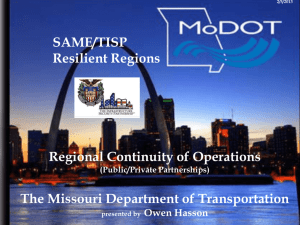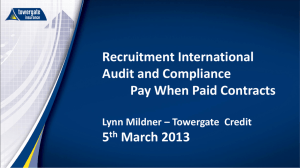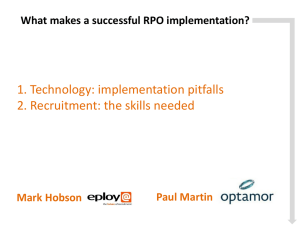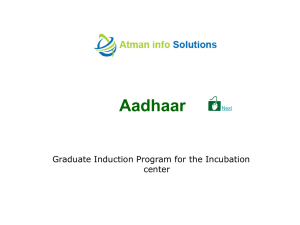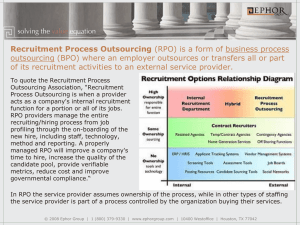The Involvement of Regional Planning Organizations in the Statewide Transportation Planning Process K
advertisement
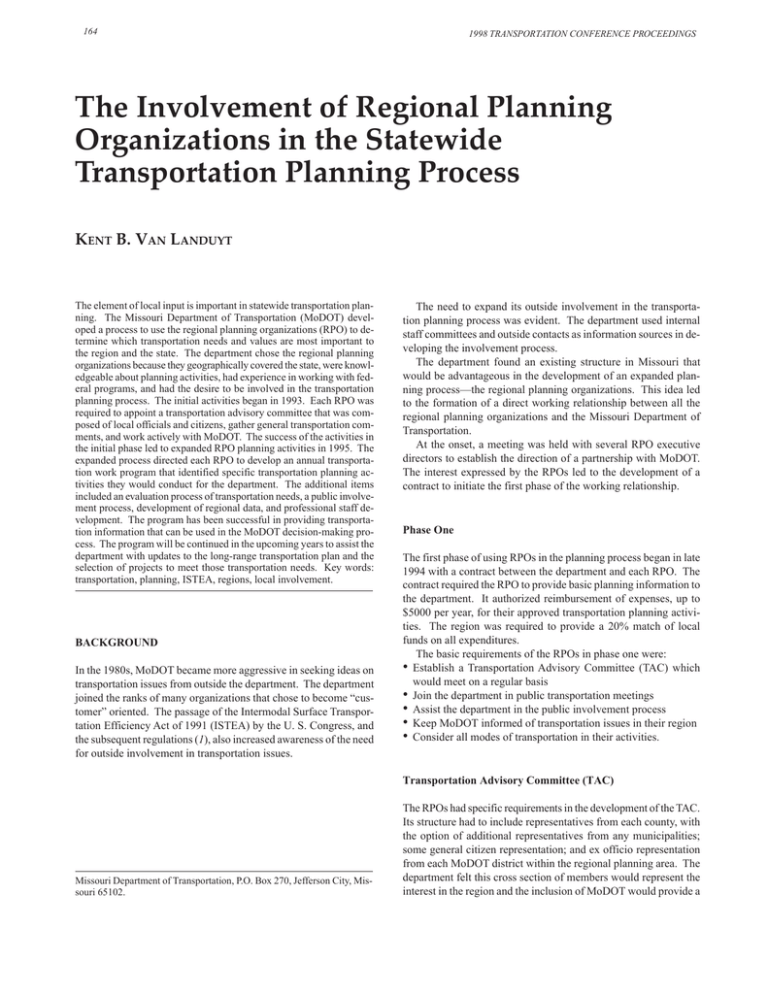
164 1998 TRANSPORTATION CONFERENCE PROCEEDINGS The Involvement of Regional Planning Organizations in the Statewide Transportation Planning Process KENT B. VAN LANDUYT The element of local input is important in statewide transportation planning. The Missouri Department of Transportation (MoDOT) developed a process to use the regional planning organizations (RPO) to determine which transportation needs and values are most important to the region and the state. The department chose the regional planning organizations because they geographically covered the state, were knowledgeable about planning activities, had experience in working with federal programs, and had the desire to be involved in the transportation planning process. The initial activities began in 1993. Each RPO was required to appoint a transportation advisory committee that was composed of local officials and citizens, gather general transportation comments, and work actively with MoDOT. The success of the activities in the initial phase led to expanded RPO planning activities in 1995. The expanded process directed each RPO to develop an annual transportation work program that identified specific transportation planning activities they would conduct for the department. The additional items included an evaluation process of transportation needs, a public involvement process, development of regional data, and professional staff development. The program has been successful in providing transportation information that can be used in the MoDOT decision-making process. The program will be continued in the upcoming years to assist the department with updates to the long-range transportation plan and the selection of projects to meet those transportation needs. Key words: transportation, planning, ISTEA, regions, local involvement. BACKGROUND In the 1980s, MoDOT became more aggressive in seeking ideas on transportation issues from outside the department. The department joined the ranks of many organizations that chose to become “customer” oriented. The passage of the Intermodal Surface Transportation Efficiency Act of 1991 (ISTEA) by the U. S. Congress, and the subsequent regulations (1), also increased awareness of the need for outside involvement in transportation issues. The need to expand its outside involvement in the transportation planning process was evident. The department used internal staff committees and outside contacts as information sources in developing the involvement process. The department found an existing structure in Missouri that would be advantageous in the development of an expanded planning process—the regional planning organizations. This idea led to the formation of a direct working relationship between all the regional planning organizations and the Missouri Department of Transportation. At the onset, a meeting was held with several RPO executive directors to establish the direction of a partnership with MoDOT. The interest expressed by the RPOs led to the development of a contract to initiate the first phase of the working relationship. Phase One The first phase of using RPOs in the planning process began in late 1994 with a contract between the department and each RPO. The contract required the RPO to provide basic planning information to the department. It authorized reimbursement of expenses, up to $5000 per year, for their approved transportation planning activities. The region was required to provide a 20% match of local funds on all expenditures. The basic requirements of the RPOs in phase one were: • Establish a Transportation Advisory Committee (TAC) which would meet on a regular basis • Join the department in public transportation meetings • Assist the department in the public involvement process • Keep MoDOT informed of transportation issues in their region • Consider all modes of transportation in their activities. Transportation Advisory Committee (TAC) Missouri Department of Transportation, P.O. Box 270, Jefferson City, Missouri 65102. The RPOs had specific requirements in the development of the TAC. Its structure had to include representatives from each county, with the option of additional representatives from any municipalities; some general citizen representation; and ex officio representation from each MoDOT district within the regional planning area. The department felt this cross section of members would represent the interest in the region and the inclusion of MoDOT would provide a 165 Van Landuyt direct connection with the department, without having to go through a number of people or bureaucratic levels. The TACs were required to meet on a regular basis. The majority of them chose to meet quarterly. Some had their first few meetings every two months and then they went to a quarterly schedule. The TACs were expected to give written and verbal input to the department on transportation needs and their ideas of what was important in their area. They were also expected to assist the department with any public meetings that would involve both agencies. The TACs were recognized as a committee appointed by the RPO Board of Directors. If they had formal positions to take on an issue they would make recommendations to their Board. The Board would then decide if they wanted to take a formal position on a transportation issue. The contract language for this process was kept very simple. It stated “The United States Congress has authorized in the Intermodal Surface Transportation Efficiency Act of 1991 (ISTEA, P.L. 102240, 23 USC Sec. 307 and others) funds to be used for transportation planning activities. The purpose of this agreement is to grant the use of such transportation planning funds to the Agency.” The remainder of the contract was all “boiler plate” items. This general contract statement allowed the department extensive flexibility in the use of federal transportation planning funds as reimbursement to the RPO for their planning activities. The first phase was general and focused on developing a good relationship between the regions and department. Since there was a maximum of only $5000 available per year we did not want to tie the process to a bureaucratic process that would be more costly to administer than the amount of funds available. Parallel MoDOT Activities The Missouri Highway and Transportation Commission appointed a subcommittee to review the department’s activities as they related to the counties and regional planning organizations in 1993. That subcommittee recommended the department work with local governments to address transportation issues. A MoDOT news release quoted Commissioner Williamson on the commission’s interest in working with the RPOs: Our planning process is open to anyone interested in transportation, and regional planning commissions help coordinate the information needed for transportation planning. Regional planning commissions are made up of local elected officials who have a significant interest in all types of transportation— aviation, rails, highways, waterways, transit. The planning commissions help avoid duplication and encourage coordination among the various types of transportation systems (2). The department also established a breakthrough team in 1994 to look at the department’s project development process. The department adopted the recommendation of that team to include the process of using the RPOs to evaluate transportation needs and assist the department in the prioritizing of projects. These additional ideas on the application of RPOs to the transportation planning process led to the development of the second phase of activities. In 1995 a team of department and RPO staff members developed the guidelines for the second phase. Phase Two The phase two guidelines increased the involvement of the RPOs. The amount of funds available for reimbursement to each RPO was increased to $21,400 for calendar year 1997 and $26,400 for calendar year 1998, an amount developed by the department and RPO team. All expended funds were required to be matched by 20 percent local funds. The RPOs were given additional requirements to meet in order to be eligible for the these funds. The requirements were: 1. Each RPO was required to develop a work program in cooperation with the MoDOT districts in their region. The work program was required to identify work tasks, explain what they accomplished in the last year, describe what they wanted to accomplish this year and list future expectations on each task. The work program was also required to show the amount of funds they expected to spend on each task. 2. The expectations of the Transportation Advisory Committee were expanded as a result of the recommendations made by the department breakthrough team. This included the development of evaluation criteria. 3. The RPO was required to submit a progress report with each quarterly billing and an annual report of activities on each work program task. The report was required to be concise but in enough detail to identify activities conducted during the year. Each RPO was required to document their achievements within the context of the work program. An example of this would be statements that support the accomplishments in the past year, the activities planned for the current year and activities identified for the longer term (next few years). 4. A work program might include a section entitled “general transportation planning” that would include additional tasks, such as mapping requests, policy ideas and statewide transportation perspectives. 5. Each RPO was expected to encourage staff development in transportation planning. 6. The development of the work program would be the primary responsibility of the RPO, with the assistance of each of the MoDOT districts within the RPO region. 7. Other areas of RPO activities would include working with the department on public involvement activities, educating the public on transportation issues, data gathering, and assisting local communities in the application process for transportation grants. All eighteen Missouri RPOs started in phase one; each chose to expanded their transportation planning processes to include the phase two guidelines. The application of the process varied by RPO, due to their regional characteristics, but the same general outcome was sought. The department and RPOs felt it was important for each of them to have the flexibility to develop their own values and needs process. The regions have diverse factors that drive their economy, such as tourism, agriculture, urban fringe, government installations, or a combination of these. It is these regional differences which needed to be recognized; therefore, the idea was to let each region develop its process in terms of the major characteristics of its area. As this process continues to develop with each RPO, it is the intent of the department to involve the RPOs in the long range planning, public involvement, data gathering and local transportation 166 awareness campaigns. The guidelines for these activities will be focused on meeting the federal transportation planning requirements and obtaining meaningful information on all transportation modes. The level of involvement will vary by region due the activities of the area, the district and RPO staff limitations, and available funds. FINDINGS The TACs held meetings with citizens in each county to develop the weighted values. The attendance at the local meeting ranged from a small group of approximately 10 in some counties to as many as 60 or more in other counties. The TAC was directed to develop a method to prioritize transportation projects based on criteria they would develop with the help of planning professionals. It was acceptable for these criteria to be unique to their region because of its individual characteristics. The criteria developed by each TAC usually included safety, economic development, connectivity with other systems, preservation and tourism as the major evaluation elements. The TACs gave these elements a value, assigned a value to each identified transportation need for each of the factors, and developed a composite score for the project. This composite score for the project was used by the department in ranking the region’s priority. The RPO staffs found that the group meetings were more successful if the staff developed most of the material on their own. The TAC involvement was not as successful when they were asked to develop the entire process on their own. The general idea was that the TAC members did not mind commenting and giving viewpoint, but did not want to spend the time developing the process. Each RPO developed this process independently of others because of the unique characteristics of their region. This resulted in a few different values but safety and economic development were consistently the higher-rated values throughout the state. The concept of preservation evolved with an unusual understanding. The preservation of the existing transportation system did not get a high rating from the participants. The department was surprised that the regions did not rank preservation as a high value and sought the reason for this phenomenon. When the participants were questioned about the reasons behind their ratings their standard response was the public expected the department to keep the existing roads in usable condition. Their response was, “You don’t go buy a new car if you can’t afford to keep up the one you own.” The department learned that the public expected the department to maintain the existing system. The building of additions and expansions to the system were identified needs beyond a well-preserved system. The success of the program varied due to interest of TAC members as well as the commitment made by district and RPO staff. The process must demonstrate success for the TAC to be effective. They have to believe the process is working and the department is using their input. MoDOT was able to incorporate their recommendations almost immediately on some items and schedule other 1998 TRANSPORTATION CONFERENCE PROCEEDINGS recommendations into the department’s plans. Some items such as signing, turning lanes and problem locations were addressed almost immediately. The major projects were included as recommended additions to the department program. Missouri has found this program to be beneficial to the department. It strengthens the department’s awareness in the local community through local involvement, allows the department to understand the transportation needs identified by the local people, builds credibility through a formal structure, and guarantees a consistent flow of information throughout the state. The Missouri program has also gained interest outside the state. Several Departments of Transportation and Regional Planning Organizations have made inquires to MoDOT on the process. The process was also featured in the January 1998 issue of Economic Development Digest. The article focused on the planning activities of the Northwest Missouri Regional Councils of Governments and the Meramec Regional Planning Commission (3). The process is also gaining some national attention in the U.S. Congress. As of spring 1998, several proposals for the reauthorizaton of ISTEA have references to local involvement in the transportation planning process. The interest is there for the states to involve the public and local officials in the transportation planning process; it will take the continued interest at all levels to develop the ideas into a working process in each state and region. SUMMARY The Missouri Department of Transportation started working with the regional planning organizations in the late 1980s, developed a formal process in early 1990s and expanded the process in 1996. The process focuses on transportation planning issues. It includes the requirement that each RPO establish a Transportation Advisory Committee that must meet at least quarterly, must develop an annual work program of activities, and must submit expenses to MoDOT for approval and reimbursement with transportation planning funds. The major activities addressed by the process include public involvement, transportation planning, needs identification, and prioritizing of projects. REFERENCES 1. U.S. Department of Transportation. Rules and Regulations for Statewide Planning and Metropolitan Planning, 23 C.F.R., Part 450, and 49 C.F.R., Part 613. Federal Register, Vol. 58, No. 207, October 1993. 2. Williamson, C. More Involvement of Regional Transportation Commissions in Transportation Work. Missouri Highway and Transportation Department News Release, No. 85G, November 1994. 3. National Association of Development Organizations (NADO) Research Foundation. Focus on Missouri. Economic Development Digest. Vol. 8, Number 3, January 1998, p. 6.
